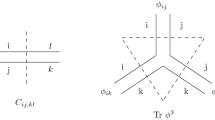Abstract
We give a brief overview of the properties of a higher-dimensional generalization of matrix model which arise naturally in the context of a background approach to quantum gravity, the so-called group field theory. We show in which sense this theory provides a third quantization point-of-view on quantum gravity.
Similar content being viewed by others
References
Ambjorn, J., Durhuus, B., and Jonsson, T. (1991). Three-dimensional simplicial quantum gravity and generalized matrix models. Modern Physics Letters A 6, 1133.
Ashtekar, A. and Lewandowski, J. (2004). Background independent quantum gravity: A status report. Classical Quantum Gravity 21, R53 (2004) [arXiv:gr-qc/0404018].
Baez, J. C. (1996). Four-Dimensional BF theory with cosmological term as a topological quantum field theory. Letters of Mathematical Physics 38, 129 [arXiv:q-alg/9507006].
Baez, J. C. (1998). Spin foam models. Classical Quantum Gravity 15, 1827 [arXiv:gr-qc/9709052].
Barrett, J. W. (1998). The Classical evaluation of relativistic spin networks. Advances in Theoretical Mathematical Physics 2, 593 [arXiv:math.qa/9803063].
Barrett, J. W. and Crane, L. (1998). Relativistic spin networks and quantum gravity. Journal of Mathematical Physics 39, 3296 [arXiv:gr-qc/9709028].
Barrett, J. W. and Crane, L. (2000). A Lorentzian signature model for quantum general relativity. Classical Quantum Gravity 17, 3101 [arXiv:gr-qc/9904025].
Boulatov, D. V. (1992). A Model of three-dimensional lattice gravity. Modern Physics Letters A 7, 1629 [arXiv:hep-th/9202074].
De Pietri, R. and Petronio, C. (2000). Feynman diagrams of generalized matrix models and the associated manifolds in dimension 4. Journal of Mathematical Physics 41, 6671 [arXiv:gr-qc/0004045].
De Pietri, R. (2001). Matrix model formulation of four dimensional gravity. Nuclear Physics Proceedings Supplementary 94, 697. [arXiv:hep-lat/0011033].
De Pietri, R. and Freidel, L. (1999). so(4) Plebanski Action and Relativistic Spin Foam Model. Classical Quantum Gravity 16, 2187 [arXiv:gr-qc/9804071].
De Pietri, R., Freidel, L., Krasnov, K., and Rovelli, C. (2000). Barrett–Crane model from a Boulatov-Ooguri field theory over a homogeneous space. Nuclear Physics B 574, 785 [arXiv: hep-th/9907154].
Di Francesco, P., Ginsparg, P. H., and Zinn-Justin, J. (1995). 2-D Gravity and random matrices. Physical Report 254, 1 [arXiv:hep-th/9306153].
Freidel, L. (2000). A Ponzano–Regge model of Lorentzian 3-dimensional gravity. Nuclear Physics Proceedings Supplementary 88, 237 [arXiv:gr-qc/0102098].
Freidel, L. and Krasnov, K. (1999). Spin foam models and the classical action principle. Advances in Theoretical Mathematical Physics 2, 1183 [arXiv:hep-th/9807092].
Freidel, L. and Krasnov, K. (2000). Simple spin networks as Feynman graphs. Journal of Mathematical Physics 41, 1681 [arXiv:hep-th/9903192].
Freidel, L. and Louapre, D. (2003). Diffeomorphisms and spin foam models. Nuclear Physics B 662, 279 [arXiv:gr-qc/0212001].
Freidel, L., Krasnov, K., and Puzio, R. (1999). BF description of higher-dimensional gravity theories. Advances in Theoretical Mathematical Physics 3, 1289 [arXiv:hep-th/9901069].
Livine, R., Perez, A., and Rovelli, C. (2001) 2d manifold-independent spinfoam theory, arXiv: gr-qc/0102051.
Markopoulou, F. and Smolin, L. (1997). Causal evolution of spin networks. Nuclear Physics B 508, 409 [arXiv:gr-qc/9702025].
Mikovic, A. (2003). Spin foam models of Yang–Mills theory coupled to gravity. Classical Quantum Gravity 20, 239 [arXiv:gr-qc/0210051].
Okolow, A. and Lewandowski, J. (2003). Diffeomorphism covariant representations of the holonomy-flux *-algebra. Classical Quantum Gravity 20, 3543 [arXiv:gr-qc/0302059].
Ooguri, H. (1992). Topological lattice models in four-dimensions. Modern Physics Letters A 7, 2799 [arXiv:hep-th/9205090].
Oriti, D. and Pfeiffer, H. (2002). A spin foam model for pure gauge theory coupled to quantum gravity. Physical Review D 66, 124010 [arXiv:gr-qc/0207041].
Oriti, D. and Williams, R. M. (2001). Gluing 4-simplices: A derivation of the Barrett–Crane spin foam model for Euclidean quantum gravity. Physical Review D 63, 024022 [arXiv:gr-qc/0010031].
Perez, A. (2001). Finiteness of a spinfoam model for Euclidean quantum general relativity. Nuclear Physics B 599, 427 [arXiv:gr-qc/0011058].
Perez, A. (2003). Spin foam models for quantum gravity, Class. Quantum Gravity 20, R43 [arXiv: gr-qc/0301113].
Perez, A. and Rovelli, C. (2001). Observables in quantum gravity, arXiv:gr-qc/0104034.
Perez, A. and Rovelli, C. (2001). A spin foam model without bubble divergences. Nuclear Physics B 599, 255 [arXiv:gr-qc/0006107].
Ponzano, G. and Regge, T. (1968). Semiclassical limit of Racah coefficients. In Spectroscopic and Group Theoretical Methods in Physics, Racah Memorial Volume, F. Block et al. eds., North Holland, Amsterdam.
Reisenberger, M. P. (1994). World sheet formulations of gauge theories and gravity, arXiv:gr-qc/9412035.
Reisenberger, M. P. and Rovelli, C. (1997). *Sum over surfaces* form of loop quantum gravity. Physical Review D: Particles and Fields 56, 3490 [arXiv:gr-qc/9612035].
Reisenberger, M. P. and Rovelli, C. (2001). Spacetime as a Feynman diagram: The connection formulation. Classical and Quantum Gravity 18, 121 [arXiv:gr-qc/0002095].
Sahlmann, H. (2002). Some comments on the representation theory of the algebra underlying loop quantum gravity. arXiv:gr-qc/0207111.
Sahlmann, H. and Thiemann, T. (2003). Irreducibility of the Ashtekar–Isham–Lewandowski representation. arXiv:gr-qc/0303074.
Thiemann, T. (1998). Quantum spin dynamics (QSD). Classical and Quantum Gravity 15, 839 [arXiv:gr-qc/9606089].
Turaev, V. G. and Viro, O. Y. (1992). State sum invariants of 3 manifolds and quantum 6j symbols. Topology 31, 865.
Witten, E. (1988). (2 + 1)-Dimensional Gravity as an exactly soluble system. Nuclear Physics B 311, 46.
Witten, E. (1991). On quantum gauge theories in two-dimensions. Communications in Mathematical Physics 141, 153.
Author information
Authors and Affiliations
Corresponding author
Additional information
Prepared for the proceedings of Peyresq Physics 9Meeting: Micro and Macro Structureof Spacetime, Peyresq, France, 19-26 June 2004.
5 Except in 2 + 1 dimension (Witten, 1988).
Rights and permissions
About this article
Cite this article
Freidel, L. Group Field Theory: An Overview. Int J Theor Phys 44, 1769–1783 (2005). https://doi.org/10.1007/s10773-005-8894-1
Issue Date:
DOI: https://doi.org/10.1007/s10773-005-8894-1




